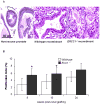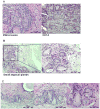Deficiency of DNA repair nuclease ERCC1-XPF promotes prostate cancer progression in a tissue recombination model
- PMID: 22212909
- PMCID: PMC3490419
- DOI: 10.1002/pros.22472
Deficiency of DNA repair nuclease ERCC1-XPF promotes prostate cancer progression in a tissue recombination model
Abstract
Background: The excision repair cross complementing (ERCC1) gene product plays a vital role in the nucleotide excision repair (NER) and DNA interstrand crosslink repair pathways, which protect the genome from mutations and chromosomal aberrations, respectively. Genetic deletion of Ercc1 in the mouse causes dramatically accelerated aging. We examined the effect of Ercc1 deletion in the development of prostate cancer in a prostate recapitulation model as Ercc1 deficient mice die within four weeks of birth.
Methods: Prostate tissues from Ercc1(-/-) mice or wild-type littermates were combined with embryonic rat urogenital mesenchyme and grown as renal grafts for a total of 8, 16, and 24 weeks before histological, expression and proliferative evaluation.
Results: Invasive adenocarcinoma was observed in Ercc1(-/-) tissue recombinants but not wild-type as early as 8 weeks post-grafting. PIN-like lesions in Ercc1(-/-) tissue recombinants had more cytologic and architectural atypia than wild-type (P = 0.02, P = 0.0065, and P = 0.0003 at the 8, 16, and 24 weeks, respectively), as well as more proliferative cells (P = 0.022 and P = 0.033 at 8 and 16 weeks, respectively). With serial grafting, Ercc1(-/-) tissue recombinants progressed to a more severe histopathological phenotype more rapidly than wild-type (P = 0.011).
Conclusions: Results show that ERCC1 and by implication the NER and/or interstrand crosslink repair mechanisms protect against prostate carcinogenesis and mutations or polymorphisms affecting these DNA repair pathways may predispose prostate epithelial cells to transformation.
Copyright © 2011 Wiley Periodicals, Inc.
Conflict of interest statement
Disclosure Statement: The authors declare that they have no affiliations with any organization that may have a direct interest in the research described, or a real or perceived conflict of interest. The funders had no role in study design, data collection and analysis, decision to publish, or preparation of the manuscript.
Figures





Similar articles
-
The ERCC1 and ERCC4 (XPF) genes and gene products.Gene. 2015 Sep 15;569(2):153-61. doi: 10.1016/j.gene.2015.06.026. Epub 2015 Jun 12. Gene. 2015. PMID: 26074087 Free PMC article. Review.
-
XPF-ERCC1 protects liver, kidney and blood homeostasis outside the canonical excision repair pathways.PLoS Genet. 2020 Apr 9;16(4):e1008555. doi: 10.1371/journal.pgen.1008555. eCollection 2020 Apr. PLoS Genet. 2020. PMID: 32271760 Free PMC article.
-
Reduced hematopoietic reserves in DNA interstrand crosslink repair-deficient Ercc1-/- mice.EMBO J. 2005 Feb 23;24(4):861-71. doi: 10.1038/sj.emboj.7600542. Epub 2005 Feb 3. EMBO J. 2005. PMID: 15692571 Free PMC article.
-
Physiological consequences of defects in ERCC1-XPF DNA repair endonuclease.DNA Repair (Amst). 2011 Jul 15;10(7):781-91. doi: 10.1016/j.dnarep.2011.04.026. Epub 2011 May 25. DNA Repair (Amst). 2011. PMID: 21612988 Free PMC article. Review.
-
Multiple roles of the ERCC1-XPF endonuclease in DNA repair and resistance to anticancer drugs.Anticancer Res. 2010 Sep;30(9):3223-32. Anticancer Res. 2010. PMID: 20944091 Review.
Cited by
-
Single nucleotide polymorphisms in DNA repair genes as risk factors associated to prostate cancer progression.BMC Med Genet. 2014 Dec 24;15:143. doi: 10.1186/s12881-014-0143-0. BMC Med Genet. 2014. PMID: 25540025 Free PMC article.
-
Emerging roles of Jab1/CSN5 in DNA damage response, DNA repair, and cancer.Cancer Biol Ther. 2014 Mar 1;15(3):256-62. doi: 10.4161/cbt.27823. Epub 2014 Feb 4. Cancer Biol Ther. 2014. PMID: 24495954 Free PMC article. Review.
-
Increased ERCC1 expression is linked to chromosomal aberrations and adverse tumor biology in prostate cancer.BMC Cancer. 2017 Jul 26;17(1):504. doi: 10.1186/s12885-017-3489-9. BMC Cancer. 2017. PMID: 28747165 Free PMC article.
References
-
- Jemal A, Siegel R, Xu J, Ward E. Cancer Statistics, 2010. CA Cancer J Clin. 2010;60:277–300. - PubMed
-
- Malins DC, Johnson PM, Wheeler TM, Barker EA, Polissar NL, Vinson MA. Age-related radical-induced DNA damage is linked to prostate cancer. Cancer Res. 2001;61:6025–6028. - PubMed
-
- Isaacs WB, Bova GS, Morton RA, Bussemakers MJ, Brooks JD, Ewing CM. Molecular biology of prostate cancer. Semin Oncol. 1994;21:514–521. - PubMed
-
- Coughlin SS, Hall IJ. A review of genetic polymorphisms and prostate cancer risk. Ann Epidemiol. 2002;12:182–196. - PubMed
-
- Dong JT. Prevalent mutations in prostate cancer. J Cell Biochem. 2006;97:433–447. - PubMed
Publication types
MeSH terms
Substances
Grants and funding
LinkOut - more resources
Full Text Sources
Medical

